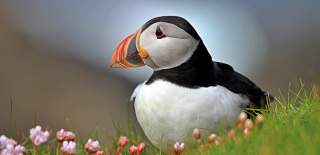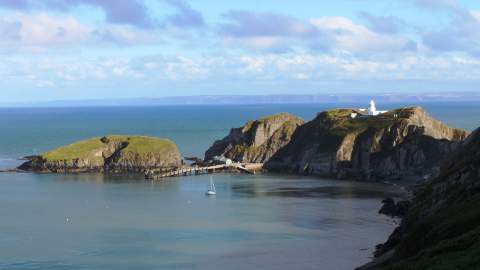Puffins in North Devon
Puffins look like they should be indigenous to far-flung places rather than the UK, but there are actually a couple of colonies living around the coast of Great Britain, including at the Shetland Islands and Skomer Island, off the coast of Wales, as well as here in North Devon.
In fact, Lundy Island, where they have made their home for generations, means Puffin Island in Norse! (Lund = puffin, ey = island.) There is nothing quite like spotting rare or exotic wildlife to make a trip feel like an adventure – so while you’re in North Devon, turn your visit into a real adventure by meeting some of Lundy Island’s most famous and exotic residents by hopping on the ferry and taking a trip from Ilfracombe.
Lundy's most famous residents
For most of the year, Puffins are out at sea, but they return to the land to breed every year and heading to Lundy during the breeding season will give you plenty of chances to spot the birds showing off their mating displays including bill-knocking and ritualised walking. Mating pairs then produce one egg each season with the chicks only emerging from the burrow when they are ready to go to sea. While it is possible to catch sight of the puffins all year round, you’re most likely to see them between the months of March and August, during their breeding season, though the Pufflings, or baby Puffins to you and I, might be spotted if you’re very quiet and happen to be near the burrows.
The puffins you see in the UK are the small auk. Puffins tend to live in burrows in short grass at the top of cliffs and feed on fish, making Lundy a great place to spot them because of the marine conservation area – where fishing is not allowed. There is a colony of puffins living at Jenny’s Cove on the island. They are often viewed from a distance so make sure to bring a pair of binoculars or a camera with a good zoom. St Philip’s Stone is another popular location for the Lundy Island puffins, but they can be seen along much of the island’s west and north coasts.
The island is a popular place for day trips (though you can also stay there!) and puffins are among its most famous avian inhabitants. The MS Oldenburg ferry offers trips from both Ilfracombe and Bideford across to the island which is open to travellers coming via ferry from March to October. Otherwise, you can catch the helicopter from November to April if you’re staying on the island.
Not just puffins…
While the chance to see puffins in the wild might be a big draw, they aren’t the only protected sea bird to call Lundy Island their home. There are a number of other sea birds that can be spotted around the island, including other auks, such as guillemots and razorbills, Manx Shearwaters and a variety of gulls.
The Manx Shearwater is one of the hardest of the island’s birds to spot, by day they are often out at sea and only really return to land at night. You’re more likely to hear them than you are to see them.
Razorbills are identified by their black backs, white chests and broad black and white bills. While they do nest in colonies, they tend to space themselves out, while Guillemots, which are brown with white plumage can be found in large groups. These breeds can often be found with the puffins as groups of auks tend to stick together, so they can also be spotted at Jenny’s Cove, though they are also prone to nesting at St Mark’s Stone.
Visitors to the island will also be able to spot Herring gulls, Lesser Black-Backed gulls, Greater Black Backed gulls, Kittiwakes and Fulmers. Look out for them all over the island!


